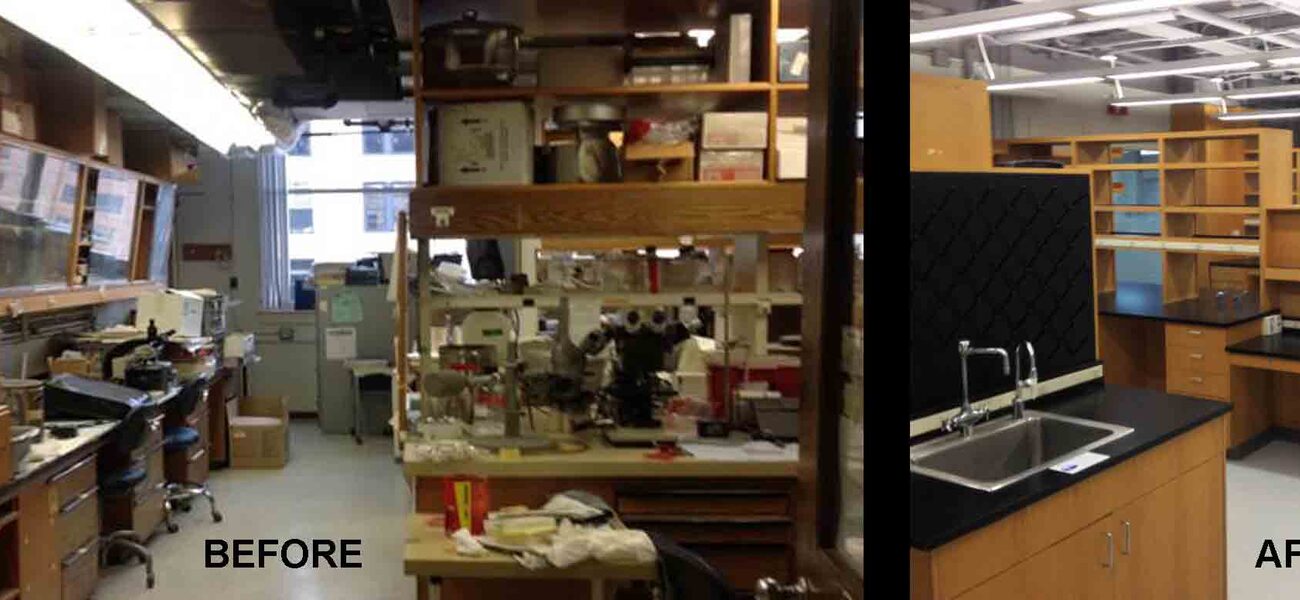Faced with aging buildings, decreased national funding, no buildable space on the urban campus, plus new research grants that required additional lab and bench space, and a medical school reorganization to consolidate eight basic science departments to four while adding two department chairs and eight principal investigators, Tufts University School of Medicine (TUSM) introduced an initiative to reclaim and reallocate available research space without new construction.
The effort, begun in 2013, shifts responsibility for allocating research space from individual faculty and departments to the University, uses a standard metric to determine space for full-time employees (FTEs), and employs a planning/change management strategy to help faculty adjust to downsizing. While the logistics are complex and require a sensitive approach with faculty, the savings are significant. Since 2013, TUSM has relocated 60 FTEs and impacted about 35,000 sf, for a total project cost of about $6.5 million. Most of the anticipated expense is for moving services and minor renovations/upgrades to existing space.
“In our situation, we could not expand the footprint. The goal was to right-size our existing lab space, and create the additional space where we needed it,” says Lois Stanley, director of campus planning at Tufts University.
TUSM is located in the Tufts Health Sciences Campus, along with the Sackler School of Graduate Biomedical Sciences, School of Dental Medicine, Friedman School of Nutrition Science & Policy, and Tufts Medical Center. Also on site are the Biomedical Research and Public Health building (BRPH), (former manufacturing buildings purchased by Tufts Medical School in 1945 and repurposed for lab space), and the Jaharis Family Center for Biomedical and Nutrition Sciences, built in 2002. Combined, they represent 500,000 sf of primarily wet lab space. The right-sizing effort involved all of these buildings, and created a domino effect, whereby moving one PI might require relocating two others, along with moving costs and logistics, plus minor repairs or renovations to reconfigure the space, and any necessary upgrades or new equipment.
“We had projects running either concurrently or in succession, and they affected just about every floor, in every building within the health sciences complex. Individually, none of these projects represented a big construction challenge, but it created a huge project management and planning challenge, requiring a large team to execute,” says Jack McDonald, senior project manager at Tufts University.
Helping the Faculty Adjust
Implementing significant workplace changes to relocate long-term faculty requires attention to detail, a sympathetic approach, and infinite patience. “An important part of the process is being understanding when dealing with the faculty, whose labs may be getting downsized. We needed to treat them with the respect they deserved while the changes were taking place,” says Stanley. In some cases, this meant acknowledging special requests.
“We had some leeway to negotiate with people on the niceties. In most cases, these things did not cost a lot, but had a huge impact on attitude toward the move and generating good will,” says McDonald. “No one would buy into the process if they were going from bad space to worse, so we avoided doing that.” In one case, a long-term professor asked for an additional 50 sf of bench space, another wanted to split his new office to create an alcove for a student waiting area. In some cases, faculty could upgrade a small piece of equipment. As a side benefit, the changes prompted some faculty to reconfigure their space.
“For some people, relocating is energizing. It’s a chance to examine their operation and consider what they need or don’t need,” adds Stanley.
Stanley and McDonald’s change management process depended on four goals:
- Initiate a shift from departmental to University ownership of lab space. For the medical school faculty and administration, this represented a major cultural change, because departments were no longer responsible for making decisions about space.
- Introduce an inclusive planning process. The TUSM leadership team, central administration leadership, and a faculty advisory committee with department chairs, were instrumental in planning. Stanley and McDonald, whose respective roles were planner and project manager, met at least monthly with two or three TUSM deans, the vice president of operations, the vice provost for research, and TUSM department chairs. Every other month, a faculty advisory group reviewed plans and were updated on the progress of various projects. TUSM leadership and the faculty advisory group also met separately and reported concerns to the larger group. “The process to keep everyone informed and comfortable with the overall planning approach was incremental, and we adjusted as needed to meet the concerns of the faculty,” says Stanley.
- Identify and reiterate goals shared by faculty, school leadership, and central administration, and frame discussions around these goals. “We all wanted the med school reorganization to succeed, and to create physical space for the new PIs and department heads. When we talked about downsizing and relocating labs, it helped to remind everyone that this is what we were driving toward. Typically, it was a department chair or dean who would do so,” says Stanley. Another goal was working with existing space, since new buildings or major renovations were not viable short-term options.
- Analyze the research lab space portfolio and infrastructure needs, using planning tools to inform space allocation, and identify opportunities to increase research space based on a standard metric. A portfolio assessment by the architectural firm Payette and lab consultants Jacobs Consultancy showed that actual TUSM research space in 2013 varied from 140 sf to 1,500 sf per FTE, compared to a 200-sf national average. “We wanted to get as close to the national average as possible, so we settled on a metric of about 240 sf per FTE as our recommended right-size, which includes a prorated share of office and support space,” says McDonald.
Allocating Space Based on Group Size
The architectural team used Revit® to develop color-coded floor plans as a planning tool. During meetings with faculty advisory groups and senior administration, the floor plans showed where people might land. Stanley still references them frequently. “These are my bible, because they include all the spatial data. We can see where the PIs are, and we can keep track of group size for each PI, keeping in mind our target metric of 240 sf per FTE,” says Stanley. Using accurate planning tools helped them reallocate and repurpose space commensurate with group size. For instance, a PI occupying 1,500 sf of lab space in one wing of BRPH, with few full-time employees, was right-sized into a smaller lab with shared equipment in the nearby Jaharis building. Eventually, the decision was made to repurpose the much smaller Stearns wing as strictly office space, and upgrade some of the lab space in the Jaharis building.
“Pushing as much research as possible into that space allows us to defer some decisions about infrastructure to a later date,” says McDonald.
Initial plans proposed mitigating off-campus leased space to save money, but this turned out to be an unrealistic goal for the near term. “Over the years, Tufts expanded quite a bit into leased facilities in the neighborhood. Our ambition was to reduce the leased space, but we have found it is invaluable for quick turn-around, for swing space, or extra non-academic office space that we don’t have on campus,” says Stanley.
Despite continuing to lease some space, the right-sizing initiative is cost efficient. The majority of the projects are categorized as moderate construction, in the range of $100 to $200 per sf, for items like adding a tissue culture room or re-purposing outdated lab space into office space. Downsizing faculty within an existing space costs virtually nothing, apart from minor upgrades like paint, flooring, and repairing or replacing casework, which generally cost no more than $200 per sf. Compared to $300 to $400 per sf average construction costs in the Metropolitan Boston area, the financial benefits represent a significant advantage of right-sizing.
McDonald and Stanley say the reorganization is a work in progress that continues to be revisited as needs change on campus. Although most faculty were not pleased about getting less space, many appreciate the advantages of lab modernizations, standard metrics for how space is allocated, and improved research adjacencies. “For some, this has become a way to re-energize their research and help move the medical school forward,” says McDonald. “We also demonstrated with this effort that University leadership, medical school administration, faculty and staff, and the Tufts operations division can identify a problem and develop and implement a workable solution using an objective, analytic process. A lot of people didn’t think we could do it, but these two years have shown it can work to everyone’s benefit.”
By Mary Beth Rohde


